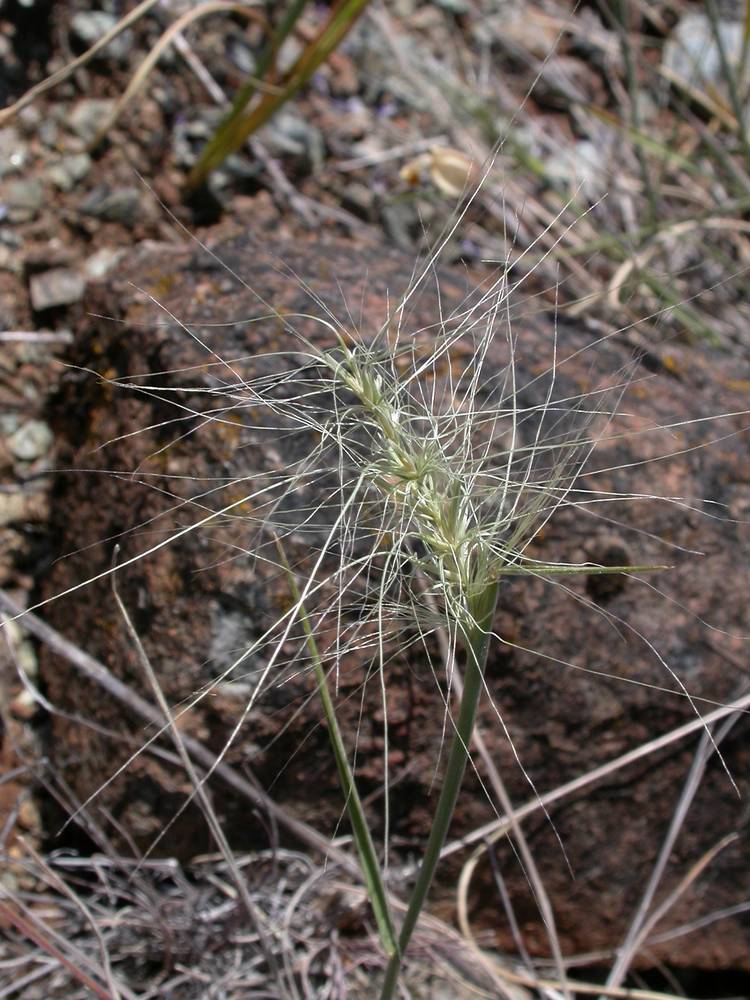Elymus multisetus
Elymus
big squirreltail
wildrye
erect to ascending.
sheaths glabrous or white-villous;
blades 1.5–4 mm wide;
upper surfaces scabrous or hairy.
usually evenly distributed but sometimes mainly basal;
sheaths open for most of their length;
auricles often present;
ligules membranous, often ciliolate;
blades usually flat but sometimes folded or involute.
5–20 cm; erect, sometimes partially enclosed in the sheath of the uppermost leaf, 2 spikelets per node or rarely 3–4 at some nodes;
internodes 3–5(8)mm;
disarticulation initially at the rachis nodes; later beneath each floret.
terminal spikes with 1–3(5) spikelets per node;
internodes 1.5–26 mm.
10–15 mm, divergent, 2–4 florets; lowest florets sterile and glume-like in 1 or both spikelets at each node.
usually appressed to ascending but sometimes strongly divergent, 1–11 florets; the distal florets often reduced; the lowest florets usually bisexual but in some species sterile and glume-like;
disarticulation usually above the glumes and beneath the florets but sometimes also below the glumes or in the inflorescence axis.
(10)30–100 mm including the awns; the bases hard and glabrous;
glume bodies about (2)5–10 × 1–2 mm, setaceous, 2–3-veined;
margins firm;
glume awns (8)25–90 mm; each split above the base into 3–9 unequal divisions, scabrous, flexuous to outcurving from near the bases at maturity.
usually 2 and subequal, usually linear-lanceolate to linear but sometimes bristle-like or oblanceolate to obovate; (0)1–7-veined, sometimes keeled over 1 vein, sometimes awned.
with densely hairy tips.
fertile lemmas 8–10 mm; smooth or scabrous near the tips, 2 lateral veins extending into bristles to 10 mm;
lemma awns (10)20– 110 × 0.2 mm at the base, divergent to arching.
linear-lanceolate, faintly 5(7)-veined;
tips acute or sometimes toothed;
teeth 0.2 mm or extended as bristles to 10 mm, often awned;
lemma awns terminal or from the sinus between the teeth; straight or curving and divergent, not bent.
1–2 mm.
3.
keels scabrous or ciliate; at least in part.
=28.
Elymus multisetus
Elymus
Dry, often rocky grasslands and savannas. 50–2000m. BR, Col, ECas, Lava, Sisk, WV. CA, ID, NV, WA; southeast to CO, south to Mexico. Native.
Elymus multisetus has inflorescences that fall apart at maturity and glumes that are divided into three to nine widely spreading awns. Very similar E. elymoides has glumes that are entire or unevenly split into two to three parts. Determining how much the glumes are split is complicated by the presence of glumelike sterile lemmas in both E. multisetus and some E. elymoides subspecies. Elymus multisetus glumes are divided above the base. If the glumes appear to be divided to the base, the plant is more likely to be E. elymoides.
Northern temperate regions. Approximately 150 species; 12 species treated in Flora.
Some species formerly treated in Elymus have been moved to Leymus, Pascopyrum, Pseudoroegneria, and Thinopyrum. Species now treated as members of Elymus include all the species formerly treated in Sitanion and some of those from Agropyron. See discussion under Agropyron. North Asian Elymus ciliaris and E. tsukushiensis were collected in Portland 1899–1903 but have not persisted. Both have one spikelet per node, lemmas with awns curving outwards at maturity and widest leaves to 10 mm wide when flat. Reports of E. caninus from Oregon are based on misidentifications of these specimens. Elymus caninus can be distinguished from all our other Elymus species by the hairy inner surface of its glumes. When keying Elymus, measurements of spikes include the awns. Measurements of spikelets, glumes, and lemmas do not include the awns (unless specified). Rachis internodes are measured in the middle of the spike. Glume widths of lanceolate to linear glumes are measured at the widest point. Glume widths of linear to bristle-like glumes are measured about 5 mm above the base of the glumes.
Barbara Wilson, Richard Brainerd, Nick Otting
Barbara Wilson, Richard Brainerd, Nick Otting
- Local floras:
CA,
OR,
WA
- Local Web sites:
CalFlora,
CalPhotos,
Flora NW,
PNW Herbaria
WildflowerSearch
iNaturalist (observations)
USDA Plants Database
- LBJ Wildflower Center
- SEINet
- Plants of the World Online
- Encyclopedia of Life
- Wikipedia
- Google Image Search
- Local floras:
CA,
OR,
WA
- Local Web sites:
CalFlora,
CalPhotos,
Flora NW,
PNW Herbaria
WildflowerSearch
iNaturalist (observations)
USDA Plants Database
- LBJ Wildflower Center
- SEINet
- Plants of the World Online
- Encyclopedia of Life
- Wikipedia
- Google Image Search




